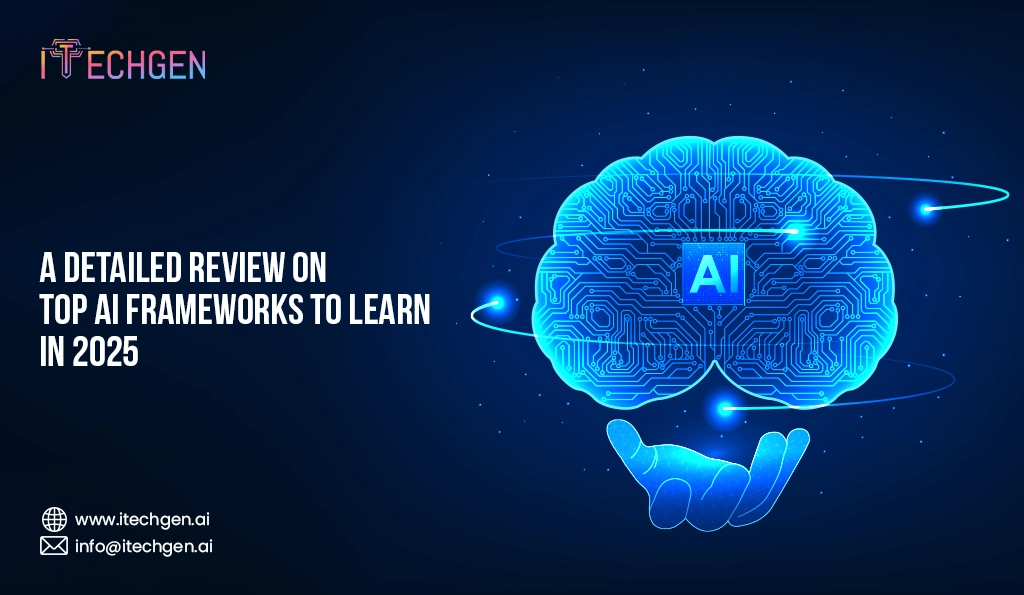
Discovering the most effective ways to implement AI development has become crucial. This has become the need of the hour because AI frameworks have become more complicated and are used in diverse applications. It includes traditional machine learning tasks, intricate deep learning processes, sophisticated neural network architectures, and so on.
As AI continues to evolve, experts are more eager than ever to learn modern techniques. They want to deploy them to discover more flexible and effective frameworks that can easily handle standard and complex AI models.
AI frameworks are pivotal in speeding up the development process, standardizing workflows, and offering tailored tools that meet specific project needs. AI frameworks provide the essential building blocks for crafting scalable and high-performing models, be it NLP, computer vision, or predictive analysis.
The AI frameworks support the ML pipeline from model training and launching to optimization using features such as multi-platform support, dynamic computational graphs, and community resources. These high-performing frameworks aid developers in building robust AI solutions that can adapt to various applications, including mobile applications and production systems.
In this blog, we will talk about such AI frameworks and explore their pros and cons to help you choose the best AI framework in 2025 for your specific AI development needs.
Every AI framework provides a myriad of benefits and strengths for diverse applications. However, each one of them also has some limitations. Keep reading to understand each of them to choose the right one for your AI integration and development project.

TensorFlow is a versatile framework launched by Google Brain. This AI framework can manage multiple and complex tasks at once, including foundational ML models, advanced deep learning algorithms, etc. It consists of a top-rate API, combined with TensorBoard’s powerful visualization tools to ease up various processes, such as training, testing, and fine-tuning AI models. This makes this AI frame an ideal choice for both expert and new developers.
Apart from its complex technical approach, TensorFlow works perfectly with various programming languages. Since TensorFlow has extensive libraries, it has become developers’ favorite framework when it comes to projects that involve natural language processing, computer vision, or predictive analytics.
Pros:
|
Cons:
|

Keras is a high-level neural network API developed to simplify deep learning model development processes. Although Keras is developed on TensorFlow, it uses a user-friendly approach and helps developers build models at a fast pace without dealing with the nitty-gritty of any technical details.
Keras supports various backends, thanks to its modular structure which makes it ideal for NLP and computer vision applications. It is mostly leveraged to speed up the projects with flexibility but many experts and beginners use it to experiment and innovate quickly.
Pros:
|
Cons:
|

PyTorch is one of the most recommended tools by both developers and researchers. Its dynamic computational graph feature makes it a perfect go-to for fast prototyping and experimentation. With a robust architectural backing for neural networks and deep learning models, PyTorch has already made waves in the most intricate areas of AI, including NLP and computer vision. This framework is highly user-friendly with a diverse range of tools for developers to build scalable AI solutions effortlessly.
Pros:
|
Cons:
|

Another great framework that works perfectly for NLP tasks is Transformers by Hugging Face. It is very useful for developers to generate texts, summarize them, and translate them using LLM models like GPT and BERT. Transformers is known for its high accessibility. With this framework, you can easily access pre-trained models, reduce setup complexities, and boost functionality. It has a vast support community that provides the latest resources and enhancement techniques, keeping Transformers well-supported.
Pros:
|
Cons:
|

Developed for mobile applications ML Kit is a flexible, multi-purpose AI toolkit for iOS and Android platforms. It empowers developers to leverage ML models to complete various tasks, such as text translation, image recognition, language processing, etc., without having any prior expertise. This versatile API supports TensorFlow Lite to integrate custom models, which extends its ability for specific applications.
Additionally, ML Kit is highly compatible with other Google applications like Firebase and Google Cloud, making it one of the best options for mobile-first developers looking to add AI-powered features to user applications.
Pros:
|
Cons:
|

Microsoft Cognitive Toolkit (CNTK) is significantly used in commercial and research projects. This toolkit consists of amazing features like efficient model training for periodic neural networks and multi-GPU support that serve various high-performance AI needs. CNTK is usually used for complex and large-scale applications. However, it is also reliable for projects that involve distributed computing, high computational power, and complex neural networks. Microsoft CNTK is not as famous as TensorFlow or PyTorch but it is best for developers who are already working within the Microsoft ecosystem.
Pros:
|
Cons:
|

Launched by GPT-4, OpenAI API is a first-rated toolkit in generative AI with the ability to generate human-like texts. It has use cases in various industries, including customer support automation, content generation, language translation, market research, content summarization, and many more. Developers love this API because of its intuitive interface, which makes its implementation easy for many text-based applications like chatbots, speech-to-text assistants, voice assistants, virtual interviews, and other language analysis tools. OpenAI’s high performance and versatility allow it to design more conversational and engaging experiences.
Pros:
|
Cons:
|

Apache Spark MLlib is a scalable ML library used in data processing. Being part of the Apache Spark ecosystem, it leverages Aparche’s distributed computing features for managing comprehensive datasets. This feature makes it ideal for NLP, predictive analytics, and recommendation systems. Apache Spark MLlib supports various ML algorithms, such as regression, classification, clustering, and collaborative filtering that help developers address a wide range of AI applications.
Apache Spark MLlib supports Apache Hadoop and can operate on clusters within a variety of computing environments. It’s perfect for scalability and industries managing large-scale data pipelines.
Pros:
|
Cons:
|
As AI solutions continue to bloom, choosing the right framework can be challenging. With a plethora of tools available in 2025, developers can build well-tailored solutions for various tasks, such as natural language processing, predictive analytics, and computer vision. This blog is for understanding the strengths and weaknesses of top AI frameworks to help you make informed decisions. Whether you are a researcher, a mobile app user, or a large-scale enterprise, these tools can help you achieve success in the upcoming AI landscape.
At iTechGen, we have immense expertise in helping businesses integrate advanced AI solutions, optimizing performance, and providing scalable AI models to meet unique needs. Let us also help you navigate the complex path of AI for your project’s full potential.

Pankaj Arora is the Founder & CEO of iTechGen, a visionary leader with a deep passion for AI and technology. With extensive industry experience, he shares expert insights through his blogs, helping businesses harness the power of AI to drive innovation and success. Committed to delivering customer-first solutions, Pankaj emphasizes quality and real-world impact in all his endeavors. When not leading iTechGen, he explores emerging technologies and inspires others with his thought leadership. Follow his blogs for actionable strategies to accelerate your digital transformation and business growth.
View More About Pankaj Arora